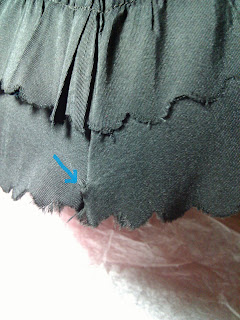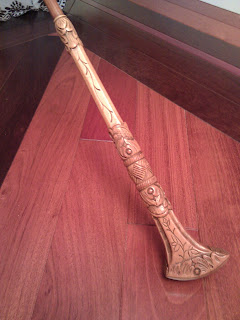There's nothing like a deadline to get you hopping on a project, right??
I needed a parasol for an outdoor event today...then, of course, today was completely overcast and verging on RAIN, so the parasol
stayed home. Poo. Ah well, at least the parasol is now DONE.
This parasol's canopy was originally the subject of
this earlier post I wrote, outlining the process of doing a large machine embroidery. The base fabric is medium weight linen, and the embroidery is cotton quilting thread on top, polyester sewing thread underneath.
I bought the frame a number of years ago, and it came to me completely bare, except for the disintegrating remnants of silk wrapping that padded the spreader joints. These I removed and replaced with scraps of linen from the canopy. The frame also had rust around the top, and a little at the rib tips, which I painted over, partly for aesthetic reasons and partly to avoid the rust from spreading. The handle is some mystery wood and the shaft is a single piece of bamboo.
Since I was in a rush, I was just going to finish attaching the canopy and use the parasol. Buuut I couldn't leave well enough alone, so I also finished the "rosette" above the slider, and the "scrunchie" around the finial (I've made up those terms; I don't really know what they would've been called for real).
In reality, the most challenging part of restoring this parasol was that it was missing the cap that parasols often (but not always) have at the top of the finial. I sacrificed a slightly expensive (but real metal) pen to make this final cap. I'd like to find a better solution, but for now, this will do.
The parasol's handle didn't need any work. I cleaned it, back when I bought the parasol, with some wood furniture cleaner, but have otherwise left it alone.
So what's with the date of this parasol? It's really challenging to pin a parasol to a precise year, let alone an exact decade. There are a number of factors that one can use to establish a date (such as the rib construction, the style of spanner joints, the overall length, and the size and shape of the canopy), but when it comes down to it, there was never only
one style of parasol in existence in any given year. Sure, there may have been a general look that was in fashion, but within that look there would have been plenty of room for variation, and who's to say that someone didn't offer styles that were just not in fashion It's not like the 1890s or 1910s had only ONE style of
shoe. We know that just wasn't true.
Anyway! By my estimation, this parasol might have been built anywhere from 1890 to 1910, so I've labeled it with a date smack in the middle.
Lastly: what have I learned from restoring this parasol? First: the canopy is
heavy. All the surviving canopies I've seen that aren't silk or lace have been fine, light cotton. Next time I do a canopy like this, I'll use cotton instead. Second: the "skirt" around the edge of the canopy doesn't really work. It tends to flip up when I open the parasol. I honestly don't think I've seen a skirt like this on a surviving canopy; skirts tend to be cut in crescents that leave the rib tips exposed. Now I think I know why!










